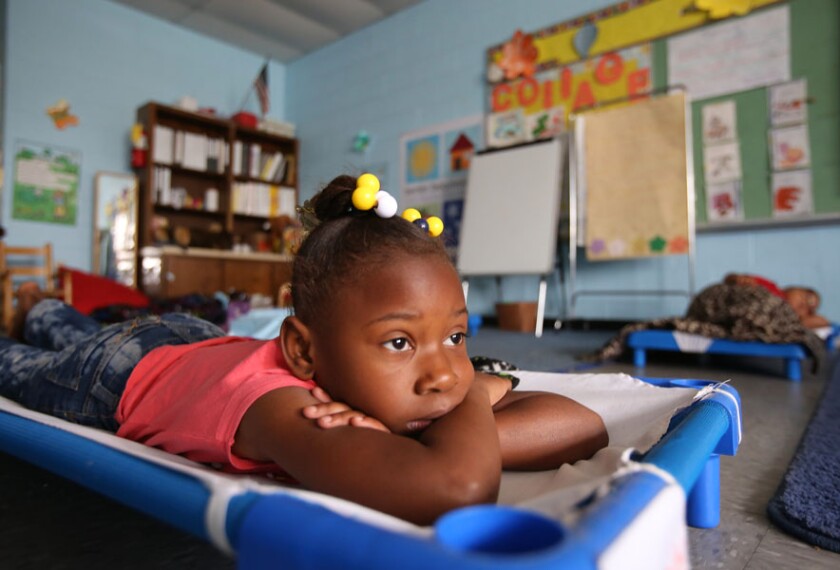For schools looking for ways to squeeze in more instructional time for young learners, preschool and kindergarten nap time can be a tempting target.
But emerging sleep research suggests cutting out the afternoon snooze can come at the expense of some children’s longer-term ability to remember what they learn.
There’s no nationwide data on how many students nap in school. But in an ongoing series of experiments funded by the National Science Foundation, cognitive researchers Rebecca Spencer of the University of Massachusetts Amherst and Tracy Riggins of the University of Maryland are tracking how young children make the transition from napping to not, and what happens if that transition is forced.
A major review of sleep research in 2015 found no benefit to forcing children to sleep if they have outgrown it, but Riggins and Spencer suggest the transition out of napping is not uniform.
“Transitioning out of naps is not a switch,” Spencer said. “A lot of developmental milestones are happening around [early grades], and as they happen, the naps come and go. They may be done napping now, but a month from now, they may be back on for a nap.”
Clearing space in the brain
To understand how that occurs, it’s helpful to look at why some kids tend to nap longer than others.
A landmark sleep study by Marc Weissbluth, a pediatric sleep specialist at Children’s Memorial Hospital in Chicago, finds that at age 4, nearly 60 percent of children still nap at least once a day. That drops to fewer than 1 in 3 daily nappers at age 5, and a little more than 1 in 10 6-year-olds who do the same.
Those years are a period of rapid growth in the hippocampus, a region of the brain that helps regulate emotions, learning, and memory, Riggins and Spencer said. They found children who still need to nap several times a week show less mature activity in both that brain region and its connections to other areas of the brain, such as those associated with critical thinking.
During a typical 60- to 90-minute nap, the researchers recorded dense, rapid bursts of electrical activity called “spindles,” that occur as the brain consolidates what it has just learned into long-term memories.
“If you want to learn all the words to your favorite song, you might tape it and replay it,” Spencer explained. “Essentially the brain is taking the video of your day, recording patterns of information in cells in the brain during the day, and replaying them in the same order while you sleep.”
But younger and less mature children run out of that “recording space” sooner than older children; they need to sleep to process what they’ve learned before their nighttime rest.
For example, the Common Core State Standards call for kindergartners to be able to draw key details from a story, an example of what researchers call episodic memory. While some other memory skills improve steadily from ages 4 to 10, children make massive leaps in their ability to remember details and context from ages 4 to 6. So in one study, the researchers asked children at six preschools to play a memory game in the morning, before their normally scheduled nap. After they had successfully completed the game, some were randomly either encouraged to nap or prevented from napping.
Later that afternoon, researchers assessed how alert both groups of children were, and how much they remembered from the morning game. Then they brought all of the children back the following morning to test how much they remembered from the previous day.
Both nappers and non-nappers were equally alert the first afternoon. But the next day, the children who were kept awake during their normal nap time forgot 12 percent to 15 percent more than students who had napped.
For about a third of students—those who are still “habitual nappers” sleeping four or more days a week—follow-up experiments showed that missing a nap significantly reduced memory in a variety of areas crucial for early learning, from motor-skill development to emotional regulation.
Pressures against rest
Some of the students who most need that time to rest may be less likely to get it, according to Peg Oliveira, the executive director of the Gesell Institute of Child Development, which studies early learning and school readiness.
Nap time “is a victim of the increased academic pressures in early-childhood classrooms,” Oliveira said. “In schools that have the luxury of students who arrive in kindergarten ready for the demands of kindergarten, they feel they can relax a little bit and provide time for naps and play. But these tend to be more affluent [public] and private schools. ... The places that feel pressure to show academic gains for students feel they don’t have the luxury to give kids these ... cognitive breaks.”
Riggins and Spencer are now tracking preschool students longitudinally as they let go of napping, to understand more about how children develop during this period. Separate studies have found that exposure to trauma or poverty can delay the development of the hippocampus, and others have similarly found that children who have been exposed to such conditions may nap for more years.
Oliveira argued that providing opportunities to sleep at school may be particularly important for children who experience trauma or unstable environments outside of school.
“It’s important to recognize those kids might not be having a solid night of sleep,” she said. “It’s essential we give them a break during the day; otherwise it’s overload.”
In schools that do have rest periods in early grades, “naps in school need to be taken a bit more seriously,” Spencer said. “Schools may provide the opportunity, but do they promote napping? People walk in and out of the classroom with full-on conversations. They should dim the room, promote quiet, and separate kids who are distracting.”
The American Academy of Pediatrics recommends 3- to 5-year-olds get 10 to 13 hours of sleep, including naps, every 24 hours.






